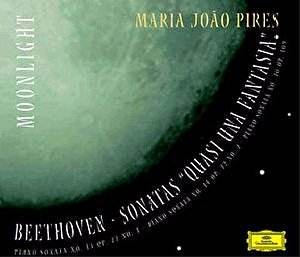There is little doubt that the presentation
of this disc is amongst some of the most stylish that I have encountered.
In amongst a selection of quotes about Beethoven from Rainer Maria Rilke,
Hermann Hesse and Wilhelm Furtwängler nestle a selection of atmospheric
shots of Belgais, home of Maria João Pires’ centre for the arts.
To learn more about this centre, visit www.belgais.net.
Belgais is obviously a place of great tranquillity.
The quotations mentioned above are presumably to evoke this atmosphere:
one does wonder, however, if so many of them are necessary when Pires
herself seems to communicate so much about the spirit of Beethoven through
the medium of music alone. She obviously chose these sonatas carefully
as they show her great strengths of touching lyricism, the ability to
convey the deepest of emotions and beauty of sound coupled with superbly
clear articulation.
The two sonatas of Op. 27 form an ideal coupling. The
E flat, No. 1, is the lesser known of the two, an unfair situation due
to universal acquaintance with the ‘Moonlight’’s first movement. Not
too far removed from Brendel in outlook in the first sonata, (try Philips
438 863-2 for the latter pianist’s recent thoughts), Pires nevertheless
has her own unique slant. If the lyrical outpouring of the Adagio con
espressione is not enough, listen to the irrepressible vitality of her
second movement (Allegro molto e vivace) or the inevitable unfolding
of the last (quite rightly, her musicality almost makes one overlook
the miracles of clarity and dexterity which mark her fingerwork).
A million and one pianists have attempted the ‘Moonlight’
before her: an infinite number will follow. But it is here in this piece
in which Pires seems to feel almost preternaturally at home: here, in
the first movement, is peace and utter serenity. This movement has surely
been attempted by even the most amateur of pianists and yet has defeated
some of the greatest: Pires is mesmeric and has the ultimate talent
of making one hear the music afresh. The last movement, predictably,
eschews the virtuoso sparks of a Pollini (his live performances have
one on the end of one’s seat). It is explosive in its way, certainly,
and there is real dynamism, but there is also space for the more lyrical
moments to breathe.
The first movement of the ‘Moonlight’ can, in the right
hands, take the listener to higher planes. Much of Op. 109 springs from
a similar oasis of peace (transcendentally so in the case of the final
movement), but in the unique and unmistakable manner of Beethoven’s
third and final period. Pires’ interpretation encompasses the requisite
grandeur and lyricism. The opening of the second movement is possibly
the only place where she deliberately hardens her tone, emphasising
the emphatic gesture, but it makes perfect musical sense in the overall
scheme. It is the mountain of the final movement which forms the recital’s
apt climax. Matters of technique are once more subsidiary as one concentrates
on the transcendental, heavenly qualities of the music. Pires realises
the structure perfectly, with exquisite shadings leading through to
the robust counterpoint characteristic of late Beethoven and on to the
trill-laden final pages and the restatement of the theme, now heard
in a very different, transfigured light. This is a reading to hold on
equal footing to Pollini’s (the late sonatas, Op. 101 onwards, are available
on a DG Originals two-disc set, 449 740-2).
The recording is, in general, superb: only in Op. 27
No. 1 do the waters of the bass occasionally muddy. This is a truly
awe-inspiring offering from Pires which acts as a reminder of what a
truly unique and inspiring musician she is.
Colin Clarke


